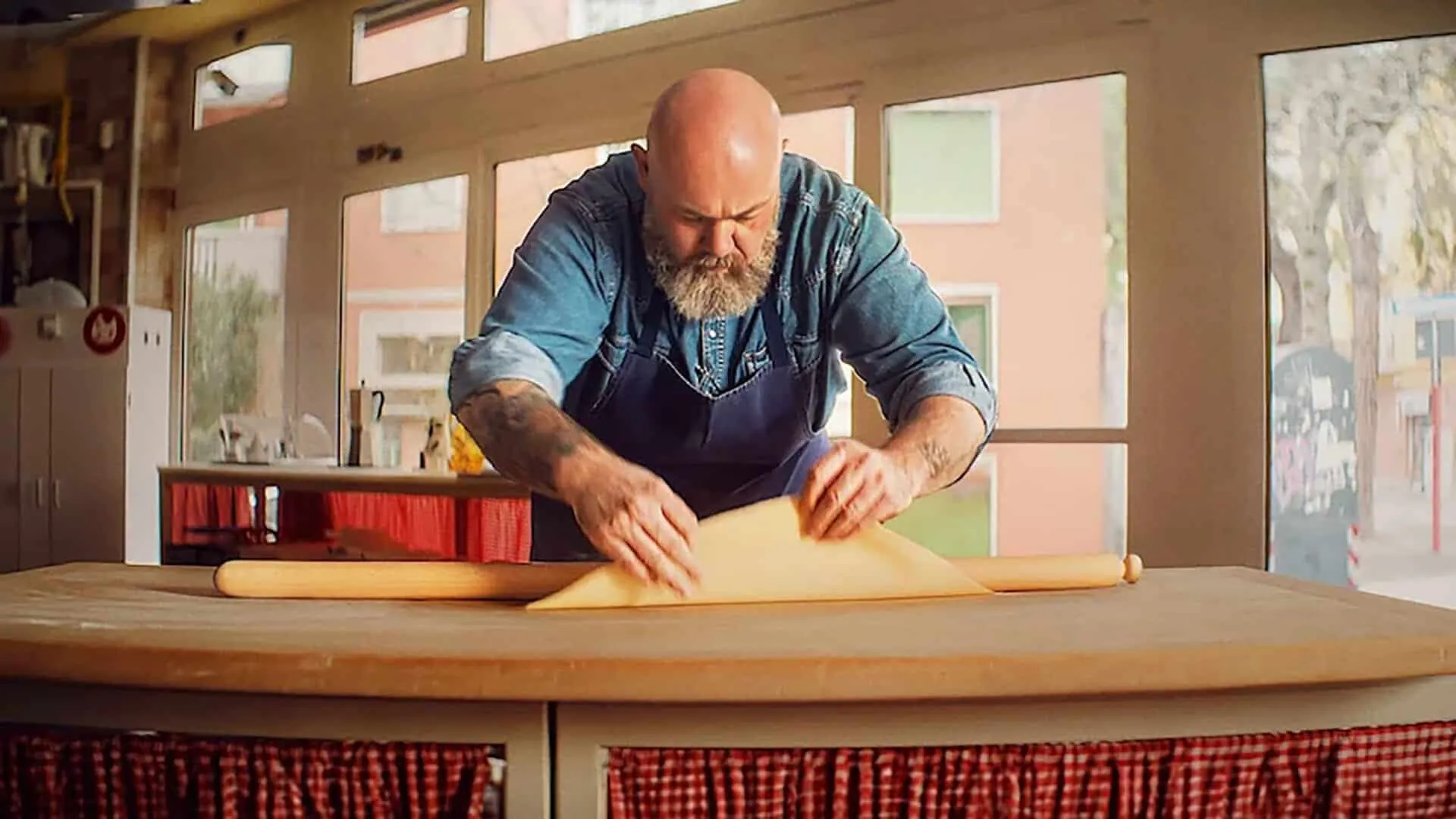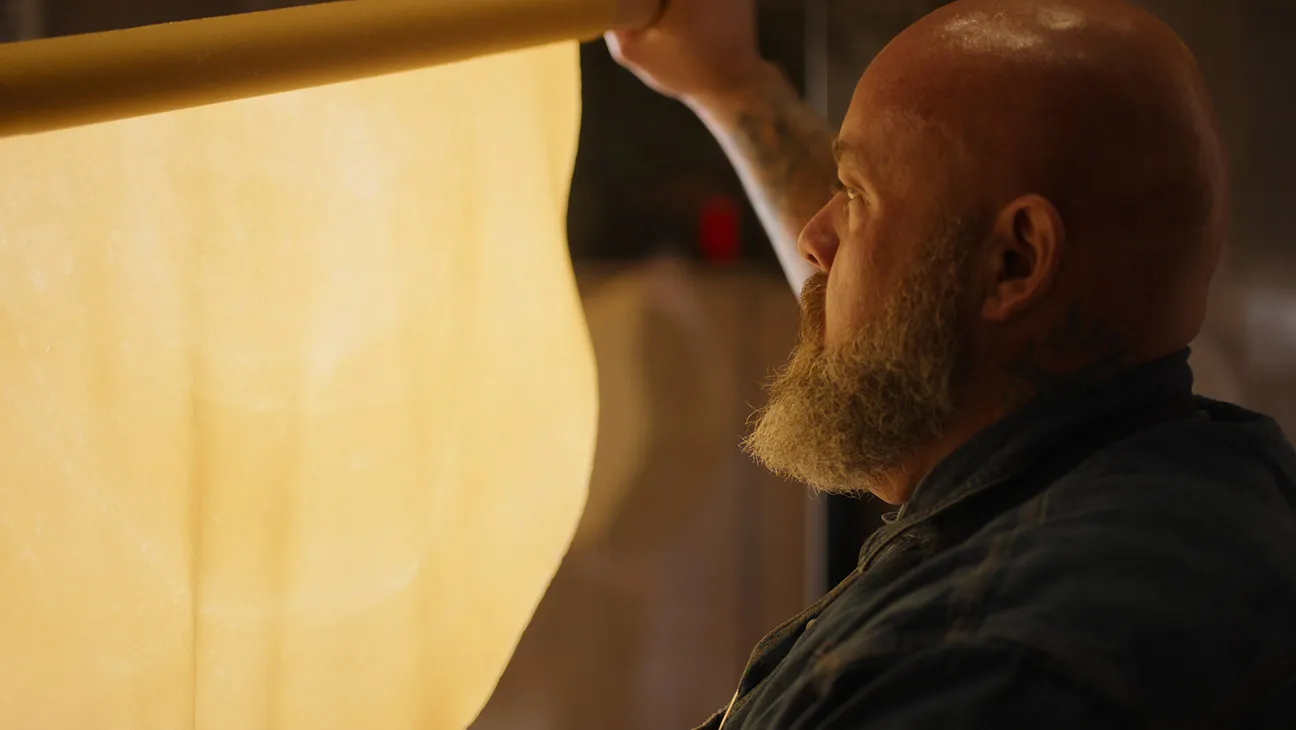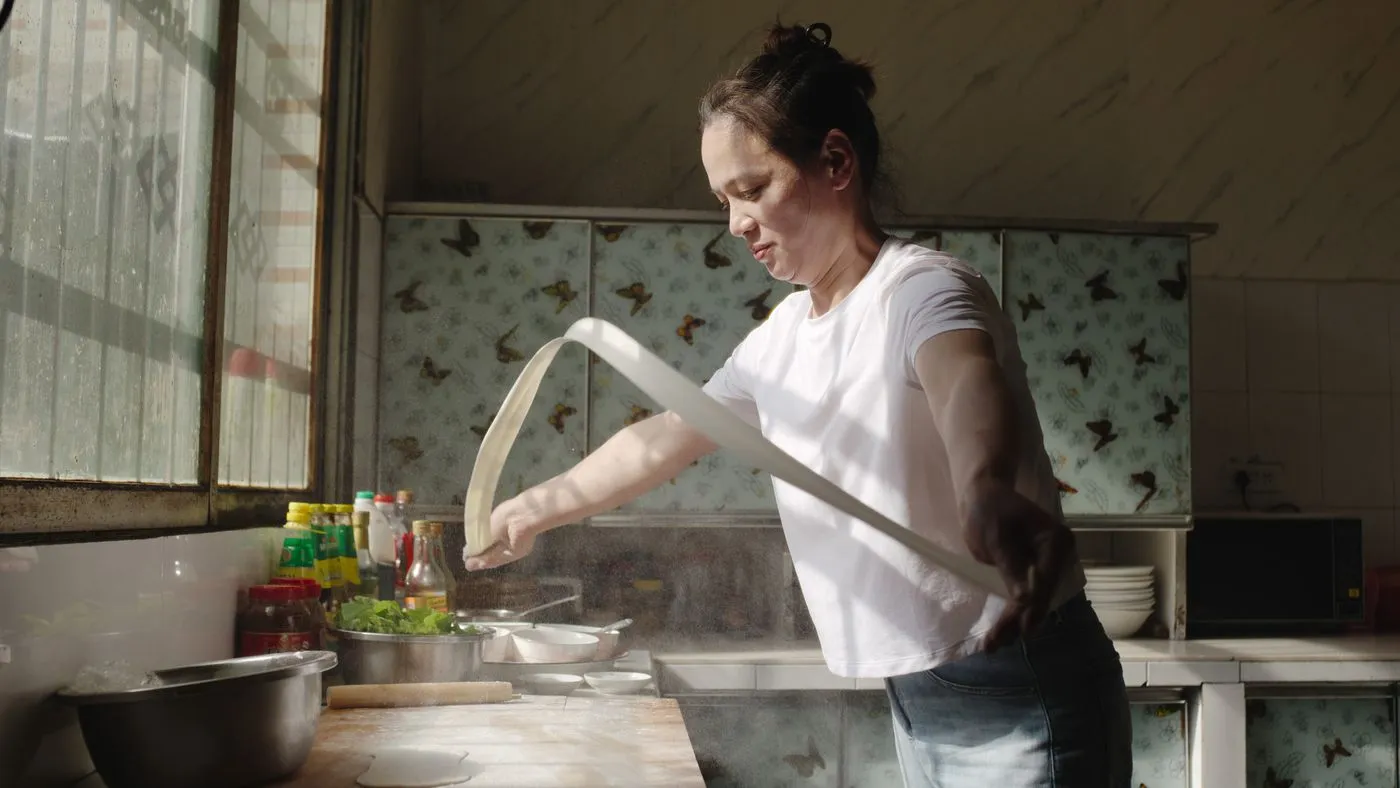“Chef’s Table: Noodles” builds on the successful Netflix series’ tradition of elevating culinary artistry into a visual and narrative feast. Each episode focuses on a great noodle maker, delving into their techniques and the rich cultural tapestries that have influenced their culinary practices.
This season focuses on four chefs—Evan Funke, Guirong Wei, Peppe Guida, and Nite Yun—who incorporate their personal stories into their craft, whether hand-rolled pasta in Beverly Hills or traditional Xi’an noodles in London. The series goes beyond just food preparation; it digs into the history and identities that shape these chefs, making each bowl of noodles a bowl of resilience and passion.
The “Chef’s Table” franchise has transformed food documentaries from simple cooking shows to significant identity, tradition, and artistry investigations.
It has set a standard for culinary television with its blend of breathtaking images and intimate storytelling, enabling consumers to view food as a cultural artifact that reflects larger societal trends and personal experiences. Each installment encourages viewers to reassess their relationship with food, upgrading it from a source of nutrition to a medium of cultural expression.
Meet the Masters: Unique Journeys of Culinary Artisans
Evan Funke’s journey into the world of pasta is as rich and textured as the dough he lovingly creates. Funke embodies culinary dedication, from his early days in a Beverly Hills restaurant to Bologna’s echoing alleyways. His approach to pasta-making is more than just food; it is based on a profound philosophy of tradition and workmanship. He feels every ingredient tells a story, so he creates pasta entirely by hand, foregoing machines in favor of a more tactile and intimate procedure.
Funke’s connection to his instructors, particularly the pasta goddess Alessandra Spisni, exemplifies a tradition of knowledge that he lovingly preserves. His journey reminds me that cooking is an art form—a blend of personal expression and cultural heritage—much like jazz improvisations, which frequently inspire my creative musings.
Guirong Wei’s investigation of Xi’an cuisine celebrates her cultural heritage and familial tradition. Her culinary journey is inextricably linked to her personal history, having grown up in China’s hilly regions. Each dish she cooks weights her heritage, from the spices that bring back childhood memories to the traditions passed down through generations.
The challenges and triumphs of Wei’s immigration experience in London are revealed as her narrative unfolds like a wonderfully textured dumpling. Her story reflects a larger cultural trend—a struggle with identity in an increasingly globalized world. In a time when so many people strive to bridge the gap between tradition and modernity, Wei exemplifies the potential of food as a narrative device, connecting the past and present with each bite.
Peppe Guida, the “dried pasta virtuoso,” relies on his Italian heritage with palpable reverence for his craft. Guida’s culinary methods are imbued with memories of his mother’s kitchen, and his story will resonate with everyone who has ever felt the pull of familial influence. This connection to his family heritage lifts his work beyond mere cooking, making it an ode to food’s nurturing power. Guida’s experience in dried pasta demonstrates a commitment to preserving tradition while modifying it for modern tastes.
His work displays a blend of individual artistry and mainstream frameworks, reminding us that, while food might be a global language, it is frequently spoken with a regional accent. This combination of personal experience and cultural expression is similar to the storylines in classic French New Wave cinema, where everyday life is depicted with poetic elegance.
Nite Yun’s narrative as a Cambodian American chef bridges the gap between her heritage and culinary identity. Her journey, which began in a Thai refugee camp, reflects resilience and the desire for belonging. Yun’s commitment to maintaining Cambodian cuisine is more than just a food commitment; it is a cultural reclamation act. Each dish she prepares is imbued with the history of her family’s difficulties, translating personal anguish into culinary beauty.
Her work questions cultural perceptions of immigration narratives, showing the complexity of Cambodian culture in an era dominated by more mainstream culinary stories. The visual and auditory elements of her episode, combined with the evocative soundtracks that accompany her cooking, create a powerful atmosphere that transports viewers into her world, much like the immersive works of contemporary directors such as Greta Gerwig, who weave personal stories into larger cultural tapestries.
Each chef in “Chef’s Table: Noodles” showcases their technical abilities and invites viewers into their lives, creating a rich tapestry of stories that resonate with a modern audience. This blend of personal narrative and culinary art provides a new perspective on food’s cultural significance, making it an engaging examination of identity and heritage.
The Craft of Noodles: Artistry in Every Strand
The precise craft of noodle making is elevated to an art form in “Chef’s Table: Noodles,” with techniques that resonate with the accuracy and grace commonly found in visual storytelling. Each chef featured in the series uses a unique technique—Evan Funke’s hand-rolled pasta is a labor of love, representing an artisanal approach evocative of the exquisite care found in classic French New Wave films.
Funke’s dedication to creating distinct pasta shapes, ranging from delicate profiles to strong pappardelle, is more than just culinary prowess; it embodies a narrative of heritage and personal connection. The camera lingers on his hands as he coaxes the dough into shape, echoing a jazz solo’s slow, deliberate pace—each movement meaningful and expressive.
The significance of acquiring high-quality ingredients cannot be stressed in this series. Underscoring a commitment to local produce and authenticity, each chef highlights the relationship between the land and their culinary creations. Guirong Wei’s tribute to Xi’an cuisine stresses the fundamental spices and textures that identify her dishes.
In contrast, Nite Yun showcases the bright flavors of Cambodian herbs, bringing viewers into a sensory experience that is both personal and universal. The increased knowledge of food origins and environmental impact among modern consumers is consistent with this dedication to ingredient quality, which mirrors broader cultural tendencies toward sustainability and farm-to-table practices.
What genuinely distinguishes “Chef’s Table: Noodles” is its reverence for tradition, seamlessly intertwined with innovation. The chefs honor traditional techniques while also reinterpreting them to suit current tastes. Peppe Guida’s emphasis on dried pasta honors his Italian heritage and showcases how traditional praxes may change.
This blend of old and new reflects a growing trend in filmmaking, with directors such as Noah Baumbach and Greta Gerwig celebrating nostalgia while stretching narrative boundaries. The series emphasizes that tradition is not static; it thrives and develops, similar to the stories we tell through film. This thread of continuity and reinvention adds an emotional dimension to each episode, enabling viewers to appreciate the lasting legacy of culinary mastery.
A Feast for the Senses: Cinematic and Musical Excellence
“Chef’s Table: Noodles” uses a cinematic technique that captivates audiences with its painstaking attention to detail. The filmmakers use close-ups and slow-motion images to create a physical connection with the food, allowing viewers to appreciate the artistry behind each dish.
These tactics suggest the intimacy found in the works of French New Wave directors such as François Truffaut, who emphasize the beauty of daily situations. Watching a chef’s hands perfectly stretch out pasta or gently plate a dish turns the act of cooking into a visual symphony, enabling the audience to savor the food and the entire process.
The musical score in “Chef’s Table: Noodles” serves as an important narrative thread, adding to the emotional depth of each episode. The soundtracks for each chef’s journey are carefully picked to resonate with their cultural origins and personal stories. Nite Yun’s part, for example, offers a hauntingly beautiful tune that emphasizes her connection to Cambodian heritage while echoing the intricacies of her identity. This clever use of music changes the viewing experience into a jazz improvisation, with each note reflecting the chefs’ trials and triumphs, making the culinary narrative all the more dramatic.
In this series, food goes beyond plain nutrition and becomes visual art. The carefully plated presentation of each dish showcases the chefs’ ingenuity and dedication, transforming pasta into a canvas for self-expression. The rich colors and textures are more than just appealing; they communicate stories about tradition and innovation.
The presentation of food in “Chef’s Table: Noodles” communicates a rich narrative, much like the aesthetic choices in contemporary films that elevate storytelling (consider the sumptuous graphics in Greta Gerwig’s “Little Women”). Each plate is an invitation to discover the cultural significance of the ingredients, creating a sensory experience that will resonate long after the episode has ended.
Stories on a Plate: Resilience, Identity, and Mastery
At the heart of “Chef’s Table: Noodles” is a tapestry comprising the featured chefs’ trials and triumphs. Each narrative illustrates not only a passion for food but also an unflinching resilience against adversity. Evan Funke’s journey, characterized by moments of self-doubt and a drive to forge his way, truly resonates.
His story serves as a reminder that mastery in any subject is frequently born from a determination to face problems head-on. Similarly, Nite Yun’s emotional investigation of her Cambodian heritage demonstrates how culinary efforts may serve as both a personal retreat and a tool for cultural reclamation. These accounts reflect a greater social change toward acknowledging the value of mental health and personal development, making the series feel fresh and relevant.
Cultural heritage is a powerful thread in every chef’s story, influencing their culinary ideas and practices. Guirong Wei’s investigation of Xi’an cuisine is more than just recipes; it is a strong connection to her roots and her family’s memories. This emphasis on identity reflects a rising awareness of the significance of food as a vehicle for storytelling in contemporary culture.
In a world increasingly defined by globalization, the chefs’ dedication to preserving their distinct culinary tales reflects a generational transition, with younger viewers keen to explore multiple cultural identities. This examination of heritage works resonates with indie filmmakers who value authenticity and personal storytelling, such as Greta Gerwig and Noah Baumbach.
The series is centered on the journey toward culinary mastery, underscoring the dedication required to master the noodle-making craft. Each chef embodies a never-ending pursuit of greatness, whether it’s Funke’s meticulous attention to detail in hand-rolling pasta or Peppe Guida’s dedication to the drying process of his masterpieces.
This emphasis on mastery is similar to cinema’s artistic ambitions, where chefs and filmmakers try to push boundaries and develop within their respective crafts. The series encourages viewers to appreciate the time and effort spent honing such skills, establishing an emotional connection between culinary artistry and cinematic art. It expresses a universal truth: excellence is frequently the result of passion, dedication, and an unflinching commitment to one’s craft.
Savoring the Stories: The Impact of Culinary Narratives
“Chef’s Table: Noodles” is a crucial edition in the beloved franchise, brilliantly combining the chefs’ culinary artistry with their narrative. Each episode investigates resilience, identity, and cultural heritage, elevating food from plain nutrition to a storytelling medium.
The chefs’ trips show the intricate connections between their lives and the dishes they create, enabling viewers to appreciate the artistry behind each strand of pasta and the history it embodies. This series showcases each chef’s technical skills and stresses the emotional depth and cultural significance that food conveys, mirroring broader societal movements toward valuing authenticity and personal tales in both culinary and cinematic settings.
When watching “Chef’s Table: Noodles,” it’s important to look past the beautiful dishes and intricate methods to the deeper stories that resonate inside each dish. The chefs emphasize that food is a universal language, rich in personal history and emotional resonance.
This series urges viewers to savor not only the food on their plates but also the narratives that shaped them. In a time when culinary skills and personal identity are increasingly entwined, “Chef’s Table: Noodles” challenges us to consider the fundamental connections between culture, identity, and the food we love. Grab a bowl of noodles and prepare to be inspired by the stories beneath the surface.
The Review
Chef's Table: Noodles
"Chef's Table: Noodles" expertly weaves personal narratives with culinary artistry, highlighting the chefs' resilience and cultural heritage. Each episode is a visually spectacular investigation of food as a profound form of storytelling, encouraging viewers to grasp the emotional complexity of each dish. The series emphasizes classic techniques while encouraging creativity, making it relevant in today's culinary world. With its rich storytelling and gorgeous presentation, this edition is a feast for the eyes and heart.
PROS
- Each episode offers rich insights into the chefs' backgrounds and culinary traditions.
- Stunning cinematography captures the artistry of noodle-making and plating.
- Personal stories add depth and context to the culinary creations.
- Balances traditional techniques with modern interpretations.
- Each chef’s journey is compelling and relatable.
CONS
- Some episodes may feel slow for viewers seeking a faster narrative.
- Concentrates primarily on noodles, which may not appeal to all food enthusiasts.
- Certain emotional arcs may feel familiar across episodes.




















































